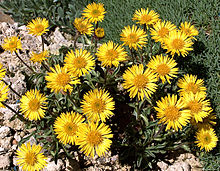
Native to the Cascades and Rocky Mountains of northwestern North America, this short-lived herbaceous perennial is a member of the aster family, Asteraceae, that also includes daisy, yarrow, and sunflower. It grows 2-8″ tall and produces a rosette of oblong to round, gray-green leaves sometimes with soft hairs, and up to 1/2″ long. An erect stem has smaller, sessile leaves and a single terminal flowerhead 1″ wide with 25-70 golden yellow ray flowers surrounding yellow disc flowers with a green center. The flowerheads are subtended by bracts with pink to purple hairs. In its natural habitat the alpine yellow fleabane lives on rock ledges and ridges and so is an excellent choice for growing in crevices, wall gardens and rock gardens. The genus name, Erigeron, comes from the Greek words ἦρι (êri) meaning early referring to the early bloom time, and γέρων (gérōn) meaning old man, referring to the hairy appearance of the fruit that resembles the beard of an old man. The specific epithet, aureus, is the Latin word meaning golden, and refer to the color of the ray flowers.
Type: Herbaceous perennial
Bloom: Flowerheads with golden yellow ray flowers surrounding yellow disc flowers with a green center in summer
Size: 2-8″ H
Light: Full sun to partial shade
Soil: Average, medum moist, well-drained
Hardiness: Zones 3-7
Care: Deadhead to encourage bloom; cut to the ground in winter.
Pests and Diseases: Generally healthy but susceptible to powdery mildew
Propagation: Seed, root basal cuttings
Companion Plants: Lewisia cotyledon, Iris reticulata, Primula auricula
Outstanding Selections: ‘Canary Bird’ (longer lived than the species)
Photo Credit:Wikidata